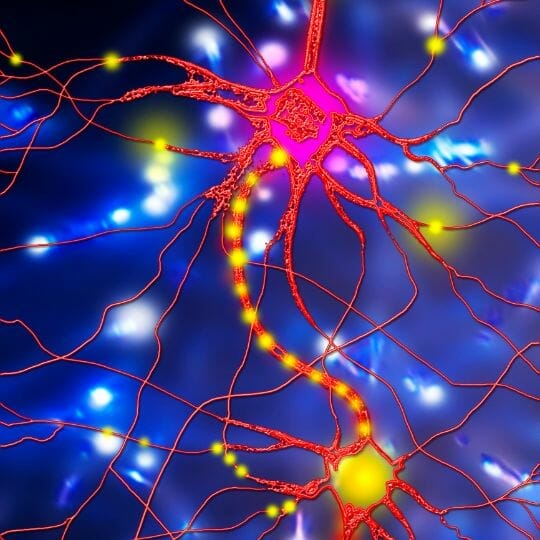
If you’ve struggled with anxiety or other mental health concerns, you know how debilitating it can be. Today we’ll discuss how vagus nerve stimulation can help you to improve these conditions, and 6 ways you can do this simply and effectively at home.
If you’ve been following me, you know that I talk about anxiety and sleep from time to time as I am dealing with those things myself.
One thing I’ve realised lately is that I regularly have a racing heart, racing thoughts, body tension and/or gut issues. A common thread for all these things is the vagus nerve.
As I explore vagus nerve stimulation as a treatment for myself, I wanted to share the idea with you and explain what it is, how it works, and how you can try it for yourself to gain a sense of physical and mental calmness.
The vagus nerve is the longest nerve in the body and is one of the main components of your parasympathetic nervous system (the ‘rest and digest’ system).
The word vagus means ‘wandering’. It ‘wanders’ from your brain stem through your throat, heart, lungs and digestive tract before descending to your abdomen.
It plays a role in regulating your metabolism and neuroendocrine-immune function, and it does this by monitoring and receiving information from your major internal organs.
The vagus nerve maintains homeostasis (maintaining a stable environment) – it does this by sending and receiving information to and from the brain and vital organs.
If there’s danger, your vagus nerve will respond with a racing heart, but if you are relaxing with some good music, the vagus nerve will regulate your breathing and slow things down.
This nerve contains both sensory and motor fibres, so it deals with both sensation and movement.
It’s also a key connection in the gut-brain superhighway, explaining why diet plays an important role in mental health and immune response. It is influential in inflammation through activation of the immune system in response to stress.
In fact, 20% of the vagus nerve fibres are efferent which means sending information from the brain to the body, whereas 80% of the vagus nerve fibres are afferent, meaning that they send information from the body to the brain.
By now, you can see that the vagus nerve is a big part of our mind-body connection. It can drive calmness and balance from the brain down to cause bodily relaxation, or from the body up to create psychological ease.
The vagus nerve’s sensory and motor functions, afferent and efferent actions and mind-body links are precisely why vagus nerve stimulation can be a powerful tool in reducing anxiety.
Neuroscientist Stephen Porges developed a theory called the polyvagal theory, which argues that the stress response can be managed through the sensory, emotional and motor pathways that are controlled by the vagus nerve.
That’s where vagus nerve stimulation (VNS) comes in.
Studies into VNS state that VNS is an approved therapy for epilepsy (with 40% of patients showing up to 50% reduction in seizures). It has also shown promising results for chronic inflammatory disorders including sepsis, lung injury, rheumatoid arthritis and diabetes, to control pain in fibromyalgia and migraines.
VNS has great potential for a wider range of applications including inflammatory bowel disorders including Crohn’s disease, as well as Alzheimer’s disease and cardiovascular disease.

VNS has shown effective as a supplemental treatment for some people with treatment-resistant depression. There is evidence of its’ efficacy for treating obsessive-compulsive disorder (OCD), PTSD, and panic disorder, and promise as a treatment for anxiety disorders.
Further study is required to overcome research challenges like small sample sizes, variability in study participants, test invasiveness, and the interaction of other factors.
But based on what I’ve just described, it’s clear that VNS can be a powerful tool for a wide variety of health concerns related to the nervous system, major organs, or both.
Having explored the application and potential power of VNS, let’s just say it won’t work for everyone, but it may help you to feel calmer, more peaceful, and lower inflammation.
The 6 ways to use VNS at home include methods that stimulate organs and muscles that are innervated by the vagus nerve – lungs, heart, vocal cords, gut and so on – so that those signals can be sent back to the brain to let it know that all is ok, you can calm down.
1. Take long, deep breaths
The 4-7-8 breathing pattern is a good example, where exhalations (8-count) are twice as long as inhalations (4-count) (the 7 is a pause in the middle).
This breathing pattern, through the nose 5 – 10 times, can slow your heart rate and send messages back to the brain to calm down.
2. Cold water on your face
Cold water on the face stimulates the vagus nerve and this may be useful for slowing or regulating a racing heart and reducing pain receptor sensitivity.

3. Singing loudly, humming, or laughing
Stimulating the vocal cords can stimulate the vagus nerve to create calmness and well-being.
4. Coughing or gargling
Coughing or gargling can stimulate the vocal cords much like singing, humming or laughing.
5. Dancing
Dancing affects the neural pathways linked to posture and balance and can communicate a sense of calmness and well-being back to the brain.
6. Yoga and/or meditation
Yoga and/or meditation involve breathwork and physical positioning that can create calmness partly due to VNS.
It would also be reasonable to suggest that exercise and healthy food stimulate the VNS through both motor and sensory pathways.
There are a couple of ways to use these techniques to help you calm your nervous system and potentially reduce anxiety.
Firstly, develop a regular practice of one or two of these activities, so that you are doing them a few times per week and habituating the calming response in your body.
Secondly, learn to recognise stress in your body and then respond by using one of these activities at the moment (rather than what you are currently doing).
For example, if I check in with myself and notice my heart is racing, I might use deep breathing for a minute to calm it down.
Or, if I feel anxious about something, I might start humming to myself instead of reaching for a square of chocolate.
To help you experiment with what works and habituate those techniques, you might like to work with a coach, or at least start writing down your plans and intentions so that you remember to take these actions regularly and stay accountable to yourself.
Today we discussed some of the research into vagus nerve stimulation (VNS), a key part of your nervous system that promotes homeostasis of metabolism, neuroendocrine function and immune function.
VNS shows promise for the treatment of various neurological and mental health concerns. There are six ways you can practice VNS in the privacy of your own home to help you calm down the nervous system and reduce the uncomfortable symptoms of anxiety, panic or stress.
These include long deep breaths (with longer exhales), splashing your face with cold water, singing or humming or laughing, coughing or gargling, dancing, or meditating.
Understanding who you are and what you need will allow your business to thrive! If you’re truly ready to break old habits and get out of the rut I encourage you to check out the Habitology membership.
Learn more here:
© 2024 Melanie White